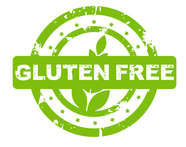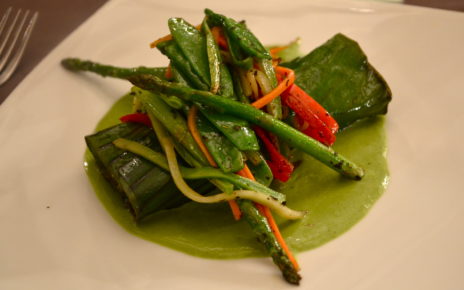For Those in the Dark: What are Gluten and Celiac Disease?
 Gluten is a sneaky type of protein that hides in wheat, barley, rye, and their derivatives. It’s also in some oats due to cross-contamination. Seems easy to just avoid those things, right? Unfortunately, gluten is hidden in countless processed foods. It lurks in salad dressings, breading, soups, marinades, processed meats, energy bars, soy sauce, beer, and many other unsuspecting places.
Gluten is a sneaky type of protein that hides in wheat, barley, rye, and their derivatives. It’s also in some oats due to cross-contamination. Seems easy to just avoid those things, right? Unfortunately, gluten is hidden in countless processed foods. It lurks in salad dressings, breading, soups, marinades, processed meats, energy bars, soy sauce, beer, and many other unsuspecting places.
According to Celiac Disease Foundation, one in 133 people in the United States suffer from celiac disease, a permanent autoimmune condition triggered when gluten is ingested (it is not an allergy). The villi in the intestines are damaged from gluten and can lead to malabsoroption and other serious health problems. Any amount of gluten is very harmful for sufferers. The CDF says the cause for the disease is still a mystery, but there is a hereditary component. The most common symptoms are GI-related, though they can run the gamut. It’s not uncommon to be misdiagnosed for a long time.
My Story
I’ve had digestive problems for years. My celiac blood test was negative, so I continued to eat bread, pasta, and other gluten-infused food. And I continued to feel like crap.
I began seeing a holistic nutritionist years ago, and she was certain I had gluten sensitivity if not celiac, especially since false negatives are common. But after dabbling with eating gluten-free, I didn’t see immediate relief, so I gave up. Fast forward to now. I’ve been reading in so many places that science is learning that some (perhaps many) people have an intolerance or sensitivity to gluten. They don’t have the autoimmune response that celiacs do, but have other unpleasant reactions such as headaches, joint aches, terrible seasonal allergies, and/or GI issues. I know people whose long-time health issues resolved after cutting out gluten.
Eating gluten-free is an all or nothing thing, and I realized I hadn’t been consistent enough to see results. Recently I’ve become almost fully gluten-free. My digestion isn’t fixed, but has improved. It’s also forcing me to eat more whole foods since gluten isn’t in veggies, fruits, nuts, or unprocessed meats–an unexpected benefit.
Help for Gluten-Free Travelers
You can cook proper food at home, and GF snacks are easy, but I realized that eating meals while traveling posed a huge challenge. What if I go somewhere where nobody knows what gluten is? How do I explain that I need to eat gluten-free in a country where I don’t speak the language? When recently Googling for help, I found Triumph Dining, a company that specializes in products that help gluten-free travelers. Hallelujah!
They sell guidebooks that that help consumers find gluten-free-friendly restaurants and grocery products across America, in addition to wallet-sized cards that communicate your needs when you’re at a restaurant. Just hand them to your waiter, and they’ll quickly understand what you can’t eat. They offer a pack of 50 disposable dining cards with the front in English and the back in Spanish for $8.95. I was excited to find out that they also sell a pack of laminated gluten-free dining cards in 10 different languages for $18.95.
I contacted the company and asked if they could give me some travel tips for gluten-free folks, and they not only said yes, but gave me a pack of the multiple language dining cards to check out on my own. Keep reading for my interview with Dave Morris from the company.

My Review
The first thing I noticed when I opened up my pack of cards is that there is an extra sheet that offers valuable tips for using the cards. The tips may seem obvious to some, but not for a total newbie. They include presenting a card to the hostess before you sit to make sure they can accommodate you, avoiding peak rush hours in order to get more attention, and trying to frequent owner-operated restaurants.
These sturdy cards come in English, Chinese, French, Greek, Indian, Italian, Japanese, Spanish (Mexican), Thai, and Vietnamese. Each one also has one side in English, so you’re able to see what it says. They are small and portable, so you can slip them in your wallet and pull them out when you’re ready to order food. You see to the right where I kept one card unfolded (this is how they are delivered) and one folded up into wallet-sized. Each card is labeled with the cuisine.
Rather than being identical, the cards are tailored to regional cuisine; for example, the one in Spanish says that flour tortillas aren’t permitted, and the one in Japanese indicates that soy sauce and imitation crab cannot be eaten. The cards also contain an important note about cross-contamination. You don’t only have to use these for travel–you can also use them when eating ethnic cuisine in your own city. You bet I’ll be using these on my upcoming trips. They solve one of the biggest problems for gluten-free travelers, and I’m so pleased that they are available in so many languages!
 Interview with Dave Morris from Triumph Dining
Interview with Dave Morris from Triumph Dining
Dave Morris kindly took the time to offer some tips for gluten-free travel.
Maiden Voyage: Why did Triumph Dining choose to make gluten-free dining guides and dining cards?
Dave Morris: We originally developed our Dining Cards to help people enjoying eating out safely at ethnic restaurants. We are a bit surprised at how many people also bring them to other countries when they travel. We are rather proud of the fact that we have sold over 125,000 cards so far and are excited that they are now available for Android smart phones and are coming out for the iPhone/iPad.
MV: Is it common for gluten-free newbies to struggle with what to eat when traveling?
DM: Without a doubt–typically because they do not have much experience in communicating their needs to the serving staff.
MV: How can travelers communicate that they need gluten-free food when they are somewhere with a strong language barrier?
DM: Our Dining Cards are a great start. Another idea is to have the concierge at your hotel recommend a restaurant and call ahead on your behalf. Since they have a long term relationship with the restaurants, they have that much more of incentive to make sure that your needs are met.
MV: Are there certain states or countries that you’ve found to be especially GF-friendly? And are there any that are particularly challenging for gluten-free travelers?
DM: Italy is certainly a great one. Most of our customers find that the more first-world a county is, the better suited for their dietary restrictions they are, and the more third-world, the less prepared they are.
MV: Do you recommend any GF blogs for newbies?
DM: We are partial to our blog, which is updated at least three times a week with pertinent content for people living gluten-free. Brittany Angell at Real Sustenance and Iris Higgins at The Daily Dietribe are wonderful.
MV: Any other thoughts or tips on surviving world travel as a GF eater?
DM: Be adventurous and enjoy your travels. Be prepared and flexible, and when in doubt, enjoy the scenery and enjoy a snack you have brought with you. Don’t let this get in the way of having a memorable time.
More Gluten-Free Travel Resources:
- Travel Tips from Gluten-Free Diva
- About.com’s Gluten-Free Travel Tips
- Sure Foods Living’s Travel Tips
- Gluten-Free Globetrotter
Do you or anyone else you know eat gluten-free? What travel tips have you learned?



